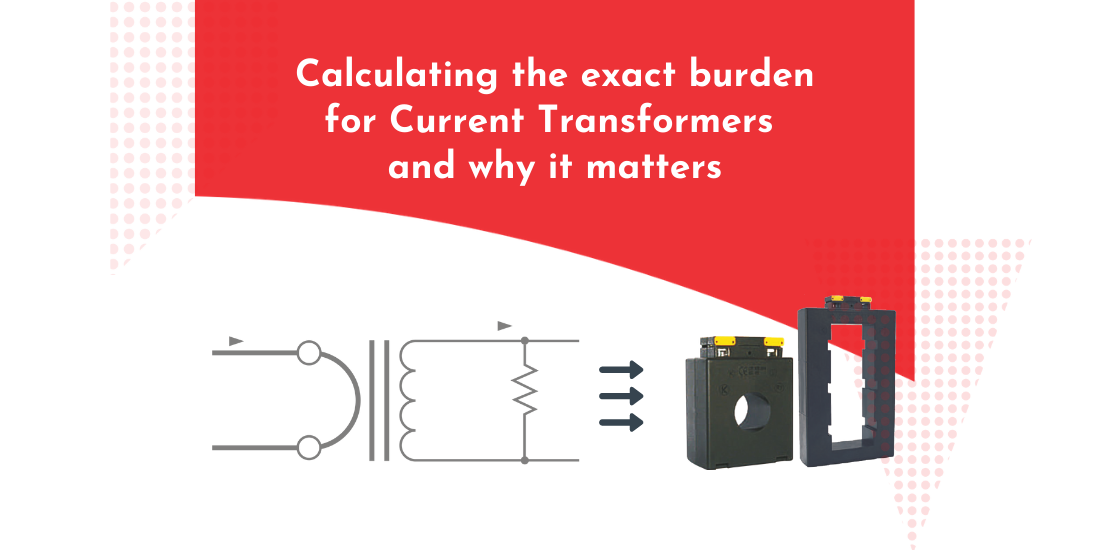- January 3, 2021
- Posted by: Dyaneshwar Nirmale
- Category: Digital Meters

Rated burden is the load burden in VA of all equipment connected to the CT secondary circuit and rated CT secondary current. Normally, the connected equipment consists of energy meter, multifunction meter, or analog meter. This load along with the load of the cable used to connect the meter is included into the burden. To calculate the total burden of a CT, the burden of the meter and wire is measured separately and then added together. Next, this figure is multiplied by 1.2 or 1.5 as a safety factor. The typical burden of most multifunction and digital meters is less than 0.2VA while for some analogue meters, it tends to be less than 0.75VA.
Calculating the right rated CT burden
The CT is connected to the meter with a 1.5 sqmm or 2.5 sqmm cable. The block in VA burden in the cables should be calculated. The burden or resistance per meter of the wire is generally given by the manufacturer and can be calculated from I2R directly. Another way to calculate it is with the equation:
VA= K x L/S
Where
L= length of the secondary cable (input/output loop) in meters
S= Cross section of the cables in mm2
K= K factor. of the CT. If the CT is 5 Amp, K is 0.5, and if CT is 1 Amp, K is 0.02
The basic burden calculation is of course I2x R where I2 is the current passing through the cable and R is the resistance of the cable.
What happens when VA burden is miscalculated
Instead of 5VA or 3.5VA, engineers often recommend burden to be 10VA, 15VA, 20 VA etc. This happens mainly when values are inflated to be on the safer side, or when the values are copied from some older drawings. Using higher burden than required extends the characteristics of the CT core, causing damage to the meter under overload conditions. Secondly, it also leads to inaccurate reading.
Instrument security factor (ISF)
ISF value is the Factor of Security of the CT. It is normally applicable for metering CTs and generally stands at 5 or 10. If the factor of security is 5, it means that the composite error of the CT at 5 times the rated primary current is greater than or equal to 10%. ISF ensures that even if the primary current increases 5 times to 500 Ams in a 100/5 CT, the secondary current will show less than 22.5A instead of 5A. Here, the heavy current on primary side is not passed to the secondary side, thus protecting the instrument. If ISF is 10 instead of 5, the secondary current will increase along with primary current, causing damage to the meter. Thus, ISF 10, 15, or 20 could be a dangerous choice to make.
IEC standard calls for the testing of the CT at full burden as well as quarter burden. So, when the users order a 15VA CT from Newtek, it is tested at 15 VA as well as 3.75 VA burden. This is the range within which the CT can measure power accurately.
The CT is not tested at less than 3.75VA. When this CT is used t 2.5 VA or 1.5 VA, the manufacturer cannot assure you of the CT’s accuracy class.
Because of these factors, it is important that the users specify the VA burden correctly.
CT is tested at 5%, 20 100 20 of the ratio. if the CT is 200/5 Amps, it needs to be tested at 10 Amp, 40 Amp, 200 Amp, and 240 Amp in order to ensure accuracy as per the standards. If the ratio is below the accuracy for which the CT has been tested, the accuracy suffers. For example, the table below shows the error percentage allowed for class I CTs. The allowed error stands at 1% for testing at 100% and 120% of the capacity, but it is not the same for lower ratios. Hence, assuming that 1% error is allowed for all ratios in a class I CT is not advised.
Maximum error allowed in case of class I CTs
| Ratio | Error allowed | ||
| 100% | + – 1% | ||
| 120% | + – 1% | ||
| 20% | + – 1.5% | ||
| 5% | + – 3% | ||
Certain CTs such as .5 and .5S are also tested at 1% of the rating. For instance, if the CT is 1000 Amp, it must be tested at 10 Amps, and a 100 Amp CT should be tested at 1 Amp. The error in this case should be within + – 1.5% . This helps ensure accuracy of measurement at lower currents as well.
Why are buyers still specifying 15 and 20 VA CTs?
15 and 20 VA CTs were popular three decades ago, when analog meters were used. The consumption within these meters itself was around 5-7.5VA. When all these meters were connected, the calculations reached around 15VA. However, now the use of digital meters is widespread, and hence, such high specifications are not required.
Instead of 15VA, 5VA class .5 CTs are best fit for more accurate results and improved instrument safety. Thus, it is prudent to choose higher accuracy CTs but lower burdens.
To avail of durable, reliable and high-performing current transformers, reach out to us at sales@newtekelectricals.com or call on +91 – 93728 62651, 93728 62635
